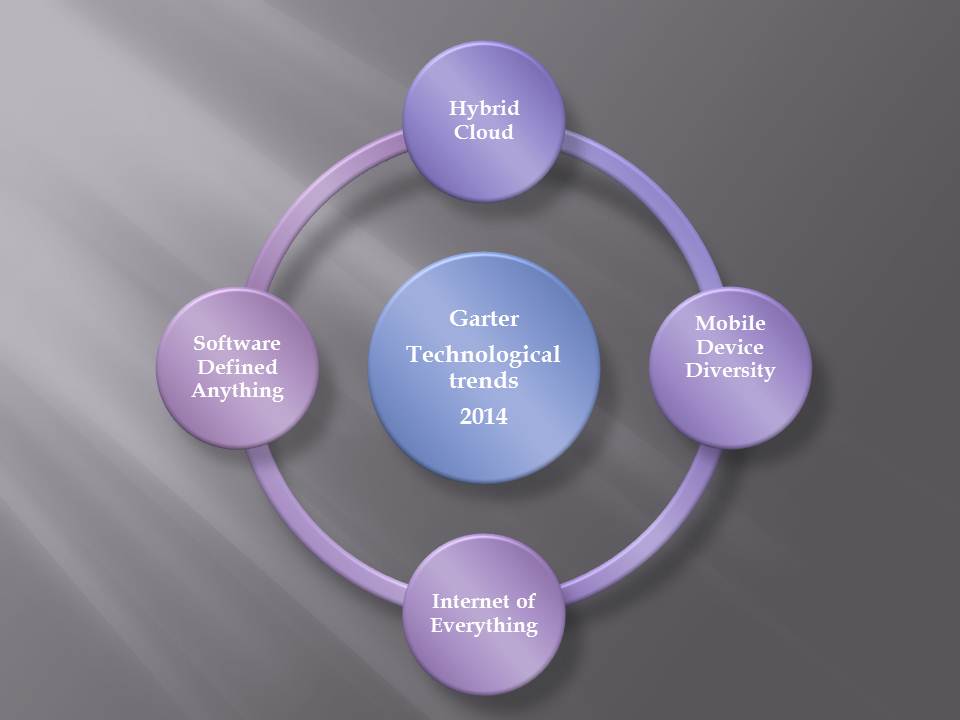
Posted by Paul Anderson
Gartner seven technological trends for 2014
Gartner, Inc. has highlighted the top technological trends that will affect organizations in 2014. In the words of David Cearley – “We have identified the technologies that companies should factor into their strategic planning processes. This does not necessarily mean adoption and investment in all of the listed technologies, but companies should look to make deliberate decisions about them during the next two years.”
He further added that the convergence of four powerful forces: social, mobile, cloud and information, will drive change in the corporate realm.
Taking excerpts from the original Gartner news, below enlisted is a summarized version of seven of those technological trends which (according to Gartner) will impact every organization’s long-term plans and programs:
Mobile Application Development
According to Gartner prediction, ‘’ in 2014 improved JavaScript performance will begin to push HTML5 and the browser as a mainstream enterprise application development environment.’’ Explaining this context further it has stated that application development will take on a more focused outlook with emphasis upon specific work and issues. Considering which, Gartner has advised developers to create expanded user interface models that involve richer voice and video quality. Doing this will help better connect people in new and different ways.
Application user interfaces that are compatible with a variety of devices will definitely have an upper edge and will witness high takers from businesses across verticals. However, to build these, a thorough understanding of fragmented building blocks and adaptable programming structure is required.
With over 100 potential tool vendors for creating consumer and enterprise facing apps, it is likely that no single tool will be optimal for all types of mobile application. Also, based on the current scenario, Gartner has hinted about the next evolution in user experience: ‘’ to leverage intent, inferred from emotion and actions, to motivate changes in end-user behavior.’’
Cloud/Client Architecture
Gartner has noted that the demand of more complex use of mobile technologies, will lead to increased levels of server-side computing and storage capacity. Cloud computing models will eventually shift to what is called a client architecture where ‘’the client is a rich application running on an Internet-connected device, and the server is a set of application services hosted in an increasingly elastically scalable cloud computing platform.’’
In the cloud/client architecture, the cloud will be the central point while the application will span multiple client devices. Again, the application can be native or browser-based.
Hybrid Cloud Service Provider
Gartner advocates bringing together personal clouds and external private cloud services. According to its report, cloud service providers should render private cloud services with a hybrid future in mind, ensuring the possibility of afterward integration/interoperability. While hybrid cloud services can be compiled in different ways i.e. from static to dynamic, it will be the responsibility of the cloud service providers to manage hybrid cloud composition. Although terms like “overdrafting” and “cloudbursting” will be used to describe hybrid cloud computing potentiality, initial hybrid cloud services will be less dynamic. They will be static, engineered compositions (such as integration between an internal private cloud and a public cloud service). More deployment compositions will emerge in the future as cloud service providersevolve.
Personal Cloud
Personal cloud era will witness a major development. There will be a power shift away from devices toward services. Management and security of the content stored and shared from the cloud will become the primary focus. Although the role of devices cannot be totally ruled out, organizations will become less worried about the specifics of devices. There will be a collection of devices used with no one particular device forming the main hub.
Software Defined Anything
‘’The demand for better infrastructure programmability and data center interoperability driven by automation inherent to cloud computing, DevOps and fast infrastructure provisioning will give birth to a new term – Software-defined anything (SDx). It will incorporate initiatives like OpenStack, OpenFlow, Open Compute Project and Open Rack.’’ Considering this new phenomena, infrastructure will be treated as a set of resources required for specific workloads. Software will be used to create an underlying infrastructure that can be managed holistically. Organizations across the globe will implement software-defined architectures for continued flexibility and control.
Individual technology suppliers will be challenged to demonstrate their commitment to true interoperability standards within their specific domains. However, initially most vendors will reluctantly abide by SDx standards (that have the potential to lower margins and open broader competitive opportunities), even when the consumer will prioritize it due to simplicity, cost reduction and consolidation efficiency.
Mobile Device Diversity and Management
‘’By 2018, devices, computing styles, user contexts and interaction paradigms will rise tremendously.’’
BYOD and Cloud Computing will double/triple the size of the mobile workforce. Consequent to which, it is advisable for enterprises to recheck their enterprise policies on employee-owned hardware usage and update/extend these if required. As Gartner states – ‘’ Most companies allow employees to access networks through devices that the enterprise owns and manages. It is important to set policies to define clear expectations around what employees can and can’t do. Employee-owned hardware usage flexibility should be balanced with confidentiality and privacy requirements.’’
>
Internet usage will move beyond cloud enterprise applications, PCs and mobile devices. Other enterprise assets such as field equipment will also get digitized. Not to forget consumer products such as cars and televisions too. By digitizing everything, enterprises (across all verticals) can make their assets and machines to leverage four usage models – Manage; Monetize; Operate; Extend
